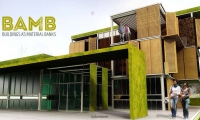With the understanding that buildings have a major impact on our natural environment, designers are challenged to make sustainable design choices; in particular long-term resource efficient choices. For making those choices today designers need insight in their future impact and they should be able to weigh future impacts against initial ones. Life Cycle environmental assessments can assist designers in making informed choices and guide them towards optimal solutions. Additionally, previous studies showed that demountable detailing supporting future transformations when needs change can provide a life cycle benefit. Nevertheless the use of demountable construction elements is limited to small scale and specific functions today, such as temporary or transitional buildings. Moreover, the use of Life Cycle assessments during design is time consuming and specific expertise is required to evaluate environmental impacts. Therefore, in this doctoral thesis it is studied how Life Cycle environmental assessments and demountable detailing can become more accessible for a larger audience.
First, for every functional layer it is analysed how buildings components can be connected in a reversible way. Second, it is investigated how those building components can be combined into building elements. In a next step, it is checked how to estimate the needed thickness of each functional layer of the demountable building element in order to fulfil several demanded requirements (such as structural, thermal and acoustical performance and fire resistance). Finally, we get an insight in the calculation of the environmental impact.
All this knowledge is combined in order to develop a decision-making model for demountable building elements. A first version of a possible implementation of the decision-supporting model is developed and can serve as a starting point to develop a user-friendly tool. By using this tool a designer can get the principal demanded requirements with a minimum of input (function, height, number of levels of the building, etc.). Consequently, the user can choose several possible materials to compose a specific construction element. In a next step, the tool will estimate how much material is needed to comply with all demanded requirements, taking into account the dimensions of existing products. If needed, the user can always adapt the output after each step, like for example if a thicker finishing layer is desired for one reason or the other. Finally the life cycle environmental impact is calculated of the construction element, including maintenance, repair end replacements and according to several scenarios (no future transformation, an average number or a maximum number of transformations). Four cases are used to test the usability of the tool, which should be further elaborated in future research. Additionally, the estimation of the performance of the construction elements should be tested in real life.





